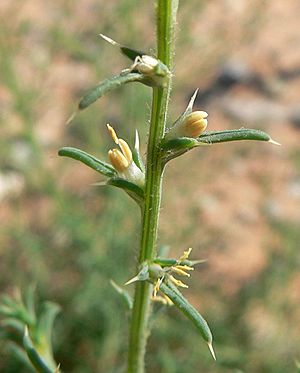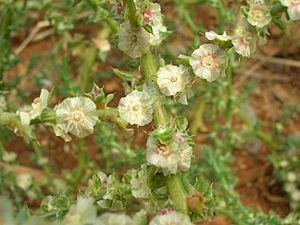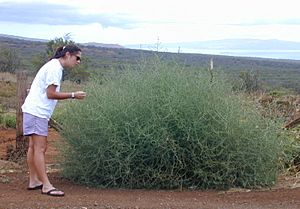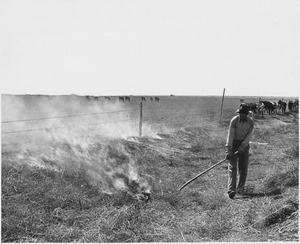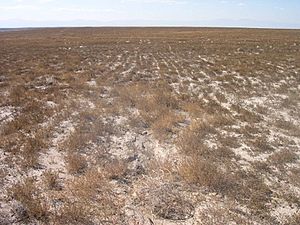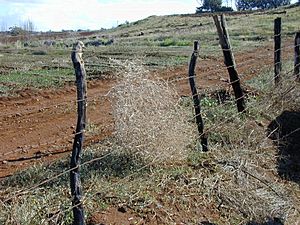Kali tragus facts for kids
Quick facts for kids Kali tragus |
|
|---|---|
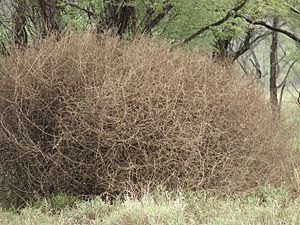 |
|
| K. tragus in tumbleweed mode | |
| Scientific classification | |
| Genus: |
Kali (plant)
|
| Species: |
tragus
|
| Synonyms | |
|
Salsola kali L. subsp. tragus DC. |
|
Kali tragus is a type of flowering plant in the Amaranthaceae family. People often call it prickly Russian thistle, windwitch, or common saltwort. Many know it simply as tumbleweed. This is because in many parts of the United States, it is the most common plant that forms a tumbleweed. It was once called "salsola" until 2007.
When Kali tragus is young, animals might eat it. But as it grows, it becomes too spiny and woody for most animals to eat. Full-grown plants can be over a meter wide. As the plant's seeds grow, the plant itself dies, dries out, and becomes hard. Then, it breaks off from its roots. This detached part is what we call a tumbleweed.
Once dry and detached, the wind blows the tumbleweed, making it roll. As it rolls, it slowly breaks apart, spreading its many seeds. A single plant can spread up to 200,000 seeds! If a tumbleweed lands in a wet spot, its seeds can sprout quickly, even with a little bit of water.
This plant can handle a lot of salt. It can grow well in places where many native plants struggle. This includes beaches, grasslands, deserts, and dry areas. Because of this, it now lives in many different places. Kali tragus comes from Eurasia. But it has spread widely and become an invasive weed in disturbed areas around the world.
Rolling tumbleweeds can harm other plants and the environment. They are also very easy to burn. This means they can help wildfires spread, especially when it's windy. A burning tumbleweed can even jump over firebreaks and set buildings on fire if it rolls into them.
Contents
Plant Classification
Linnaeus first named this plant Salsola tragus. Later, Giovanni Antonio Scopoli gave it its current name, Kali tragus.
Kali tragus is originally from Eurasia. But in the 1870s, it arrived in South Dakota. It came with flaxseed from Russia that had Kali seeds mixed in. People first thought it was just one type of weed. But now we know it includes several similar species and some mixed types (hybrids). This has made it confusing to classify these plants in America.
Scientists now believe that what was called Salsola tragus is actually three or more similar-looking species. These species have slightly different flower sizes and shapes. These plants used to be in the family Chenopodiaceae. But now, the Chenopodiaceae family, including Kali and Salsola, is part of the Amaranthaceae family. They are in a group called Salsoloideae.
What the Plant Looks Like
Kali tragus is an annual plant, meaning it lives for only one year. When it's young, it grows straight up. But as it gets older, it forms a round, tangled bush with many branches. Each branch can be up to a meter long.
The leaves and stems can be green, red, or striped. They might be smooth or hairy. The leaves have sharp spines at their tips. Most types are so spiny that you need gloves to touch them. However, some types have only a soft hair at the tip.
Young leaves can be over 5 cm long, thick, and round. These early leaves fall off as the plant gets older. The leaves on a mature plant are tough, shorter (less than 1 cm), stiff, and spine-tipped. They stay on the stem until the plant dies. Each mature leaf has two small, leaf-like parts called bracts, with a flower between them. The flower has no petals. Instead, it has a disk of wide, winged sepals that are white to pink.
How it Lives and Spreads
Reproduction and Life Cycle
As the plant's fruits grow, the plant becomes woody. When the fruits are ripe, the plant starts to die, dries out, and becomes brittle. At this point, the base of the stem breaks off easily, especially in strong winds. The plant then rolls away with the wind, spreading its seeds as a tumbleweed.
A large Kali tragus plant can produce about 200,000 seeds!
Invasive Nature
Kali tragus has spread very quickly as an introduced species. It has become a common weed in disturbed areas in many parts of North America, especially in the Midwest. It has also become established in parts of Central and South America, Southern Africa, and Australia.
This plant now lives in many different types of habitats. It is often the first plant to grow in places where no local plants can survive. Because it likes sand and can handle salt, it often grows along beaches. It also thrives in disturbed grasslands and deserts, especially in dry regions.
Can You Eat It?
You can eat Kali tragus when it is young. The young shoots can be picked and eaten. But as the plant gets older, it becomes too woody, bitter, and spiny to eat. Young shoots can be eaten raw in salads. They are said to taste even better when cooked. Young plants are also good food for livestock.
Some types of Russian thistle can have high levels of oxalic acid, especially older plants. People who are sensitive to oxalic acid should avoid eating this plant. If you have bad reactions to eating spinach, which also has high levels of oxalates, you should not eat Russian thistle.
Ecology and Farm Management
Kali tragus is an annual plant that grows in disturbed areas. Its seeds sprout quickly even with very little moisture in dry places. When it is young, animals can graze on it easily. But this phase doesn't last long, and it usually happens when other food is plentiful. After this, it becomes a weed. This is because most types become too spiny and woody for animals to eat.
As its fruits ripen, the plant dies, dries, and becomes hard and brittle. This is when it breaks off and becomes a tumbleweed. As tumbleweeds go, it is very large, often a meter or more wide. It is spiny, mostly inedible for livestock if not processed, and a fire risk. However, in places with a lot of winter rain, the moisture softens the twigs and spines. Then, tough livestock breeds and some wildlife will eat it again.
Kali tragus has a bad reputation because it is spiny, woody when mature, and very competitive. Its tumbleweed nature helps it spread quickly over open ground. For a long time, most writings about it focused on how harmful it is and how to fight its spread. They often ignored its other uses.
However, even early writings admitted that the plant is useful as food for animals in very dry conditions where few other plants can grow. While most authors focused on its invasiveness, some did mention its value in helping land recover from overgrazing or other damage.
Besides its use for cattle and sheep in some areas, Kali tragus provides food and shelter for several wild animals. It is rich in minerals, Vitamin A, and phosphorus. It is a small part of the diet for bison, mule deer, and wapiti. Pronghorn eat it only when there's a drought, but they love it when it rains, especially in wet years. Prairie dogs eat it a lot wherever they find it. Birds and small mammals like rodents eat its seeds.
Kali tragus also offers shelter for some wildlife. Medium-sized deer use it a bit, but it is mainly helpful for small mammals and birds that live close to the ground and hide under bushes.
Some livestock, like camels and certain breeds adapted to dry areas, will eat the spiny plant when food is scarce. Many goats and some sheep breeds, like karakul, eat the bushes. The plant is rich in good quality proteins and amino acids. Its seeds are even more so.
Kali tragus and similar plants are valued in their home regions, even if they are considered weeds elsewhere. They are good for harsh environments where other plants don't grow well. In Uzbekistan, for example, its stems, fruits, and leaves are good camel food all year. Sheep and goats prefer it in summer, but also eat it in autumn and winter. The fruits are important for fattening camels, goats, and karakul sheep.
In these regions, annual Kali species are known as "solyanki." They are important food sources that can handle drought and salt. They are a main group of plants in very challenging environments. Some are useful for stopping sand dunes from moving and for fixing damaged grasslands, like the salty soil of the red desert of Kyzyl Kum. Some species also grow in disturbed sites or as weeds in farm fields.
Even though Kali is not widely recognized in modern livestock nutrition in many countries, it was very important during the Dust Bowl era in North America. When usual hay crops failed, farmers fed their cattle tumbleweed, which helped save the cattle industry.
Kali Management and Soil Repair
Even though many think Kali tragus is harmful, it is very useful for repairing certain types of damaged land. Often, its presence is good, especially if the original topsoil is still there. This plant does not host mycorrhizal fungi. Many other common plants do. So, when mycorrhizae from the topsoil get into Kali roots, they often kill the plant.
When the Kali plant dies, the mycorrhizae eat what they can. Then, they spread out and infect more plants. This helps most desirable grasses and other plants, but it harms most of the Kali that was in the soil. The dead Kali plants enrich, mulch, and aerate the soil. This helps other plants that work well with mycorrhizae to grow back.
Above ground, any dead Kali plants that are still standing provide shade for other plant seedlings. Kali plants themselves do not like shade. They are adapted to open, bare soil. This process helps the soil recover better and faster than killing the Kali with herbicides and waiting for other plants to grow.
In disturbed areas with no topsoil and few or no mycorrhizae, Kali might stay the main plant for over ten years. To speed up recovery, it's better to add rich topsoil with organic material and mycorrhizae than to try to get rid of the Kali. However, it's important not to think too simply about these relationships. In some cases, healthy Kali plants on a harsh site without mycorrhizae actually seem to help grass grow better than when mycorrhizae were added to reduce the Kali population. The effect of Kali should be checked in each case. Also, where damaged soil is completely barren, Kali is better as a pioneer plant than leaving the soil empty. Kali grows best on sandy or loose soil. So, it might be good to rake the soil to encourage Kali to grow for a few years until it has improved the conditions.
Another thing to remember about Kali is overgrazing. In areas where other plants grow with Kali, overgrazing can help the weed. But managing how much animals graze to help the desired plants can be the cheapest and most effective way to control its growth. For example, controlling Kali on Bighorn Sheep Winter Ranges in Jasper National Park was done by managing grazing.
Kali and Soil Cleaning
A special way to fix soil is called phytoremediation. This is when plants are used to remove and collect harmful elements from the soil. Places like mine dumps are often very disturbed and have fine soil. Kali species show promise for certain types of this work. Just by growing in high numbers, they can help stabilize the soil. They reduce wind erosion and other processes that spread pollution. The dry tumbleweed material has also been used as a mulch on replanted coal mine spoils in Arizona.
These plants also show promise for cleaning soil by absorbing certain harmful chemicals. These are often heavy metals like cadmium, chromium, lead, arsenic, copper, nickel, and zinc. Studies have looked at Kali for all these elements. Kali was good at absorbing all of them. It might even be a "hyperaccumulator" for copper and cadmium. It definitely absorbed lead and arsenic very well, and also chromium in its most toxic form.
It's not yet clear if Kali would be useful for commercial soil cleaning. But there are different types of the plant that could be chosen for this purpose. For example, the elements the plant absorbs are held by different natural acids or groups.
However, a plant that has absorbed high levels of toxic substances (like arsenic, lead, or cadmium) would probably not be safe for food or animal feed. So, areas where plants are used for soil cleaning would need to be protected from livestock.
Future Improvements for Kali
Scientists have suggested that this plant should be used more for its good qualities. However, Kali plants in the wild are very different from each other. Besides their natural genetic differences, invasive populations have mixed with other Kali species that were brought in at the same time. Also, there are differences in the number of sets of chromosomes (ploidy).
Because wild plants are so unpredictable, farmers who have tried to grow Kali might find that seeds from wild plants don't produce the crops they hoped for. So, they tend to give up.
However, even with these challenges, the plant's genetic differences mean there are chances to make it better through breeding. The presence of plants with different chromosome sets (tetraploids and hexaploids) improves the chances of new types appearing. This species and its mixed types have caught attention as good candidates for breeding for different farming uses. The best and worst traits of the plant can be separated. This means you can choose plants with good qualities, like high protein, without also choosing bad ones, like spines.
To understand how much the plant can vary, look at these examples from about 70 samples collected in the southwestern United States:
- crude protein (how much protein)
- 5.4% to 22.3%
- acid-detergent fiber (how much tough plant material)
- 20.1% to 48.8%
- acid-detergent lignin (how woody it is)
- 3.1% to 10.4%
- nitrate (a chemical compound)
- 0.1% to 6.2%
- water-soluble oxalate (another chemical compound)
- 0.2% to 9.1%
These are just a few examples, but they show how much the plant can differ. Notice that the highest values are much larger than the lowest values. For example, nitrate content can be more than 60 times higher! Other physical traits like size and spininess also vary a lot.
As mentioned, in many areas, the plant is most edible when young. But this is often before animals need food the most. However, some types are not spiny. This means we could breed types that are useful for most of the growing season.
Also, some things, like protein, should be as high as possible. But others, like nitrate and oxalate, can be harmful at very high levels. For example, too much nitrate or oxalate can poison livestock. Plants chosen for lower levels of these chemicals can be fed without special care. But plants with high levels would need to be mixed with other, safer food, or treated. For example, you can add lime to food to make excess oxalate harmless. The plant's digestibility also varied, but it was generally easier to digest than grasses.
Another good quality of Kali tragus is that it can handle salt in dry, sandy places. In fact, it seems to grow best at salt levels that are too high for most other crops. Growing the plant in salty environments, even if it stresses the Kali, can actually make it better as animal food. It increases the total nitrogen (protein) content but reduces some potentially harmful substances like oxalate and nitrate.
Other Issues and Uses
One problem with Kali tragus is that it often causes a fire risk. First, it burns easily when dry, partly because of its high nitrate content (sometimes over 6% of its dry weight). Second, after a lot of Kali has grown, strong winds can pile up huge amounts of tumbleweeds. These piles can cover entire buildings or trap vehicles. If the dry material catches fire, it can be very dangerous. When they pile up against wire fences, the wind's force can damage the fence, and fire will too.
In wildfires in open areas, strong winds often blow burning tumbleweeds across firebreaks. This makes it hard to control the fire. When burning tumbleweeds stop against buildings or haystacks, they can set them on fire more easily than other tumbleweeds. This is because they are compact and woody when mature, and very flammable.
Kali tragus has also been linked to allergic reactions in some people. Many people get skin rashes or other reactions after touching the plant. Scratches from its spines or hard stems can cause itchy or inflamed skin. Also, this plant, and most plants in its family, are pollinated by wind. In some areas, their pollen can make up to 5% of all pollen in the air, causing many allergies.
Some species are also harvested to get compounds like "salsolin," which is used to make certain medicines.
In its dry, tumbleweed form, the plant is usually hard to work with. It's springy, spiny, flammable, and brittle. But like other dried plant materials, it has been baled and used to build houses in places like parts of Nebraska, where wood and even sod were scarce.
Experiments in Turkey suggest that chopped, ground, and pressed Kali tumbleweed, sometimes with other organic waste like sawdust, can be used as a fuel in rural areas.
When it first sprouts, before it develops spines or tough fibers, Kali tragus has been suggested as a salad, stir-fry, or potherb for people to eat. These dishes would be harmless in small amounts or if the plant type used has low oxalate and nitrate content.
Images for kids
-
Kali tragus on the Hawaiian Island of Kahoʻolawe.
See also
 In Spanish: Barrilla para niños
In Spanish: Barrilla para niños



